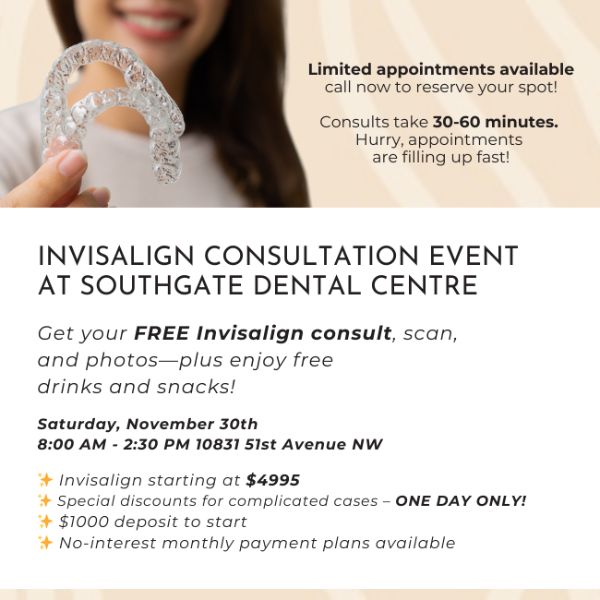Invisalign: When Can Patients Expect Results?
Invisalign is an alternative to traditional orthodontics. Compared to bracket-and-wire braces, Invisalign has a sleeker appearance. Many patients choose Invisalign because, like its namesake, it’s almost invisible.
Invisalign has its pros and cons, but its advantages can motivate some patients. Besides the attractive appearance, Invisalign may also be a quicker option for correcting many dental issues.
But how quick is it? What timeline can patients expect with Invisalign?
Who Can Benefit from Invisalign?
Invisalign is an orthodontic treatment for alignment issues. Invisalign can be an effective treatment for:
Many patients can benefit from aligners, but more complex teeth issues may not be compatible. Additionally, it may take longer than average for some severe alignment issues to complete a treatment plan.

How Long Does Invisalign Take?
Your teeth are unique, and no two treatment plans work exactly alike. For example, someone with severe alignment issues will need more time than someone with mild alignment issues. However, some patients may complete their Invisalign treatment in 6 months.
Although your treatment program may take up to 2 years, many patients begin seeing positive results in weeks.
In most cases, your dentist will provide you with a number of aligners and most patients can expect to change their aligners every 2–4 weeks. However, you may be instructed to change them even every week, depending on your treatment plan.
Although you may experience some discomfort during the first few days of getting a new aligner, you might also notice improvements with each adjustment.
On average, patients experience final results in less than 2 years. But some factors can extend or shorten the wait for alignment results.
What Impacts Your Invisalign Timeline?
Your natural alignment (before Invisalign) is one of the most significant indicators of treatment duration. Although patients can’t use dental hygiene or willpower to change their starting point, there are other factors that may impact the treatment timeline.
Age
Age is another aspect impacting treatment speed. Of course, orthodontics and alignment treatment can work at any age, but adults may experience slower results. Adults have stopped growing, resulting in higher bone dentisity so it’s more challenging to influence tooth movement.
Older adults are also more likely to experience dental issues, such as gum disease, which can cause bone loss and effect tooth movement.
Compliance
When you begin your Invisalign treatment, you’ll probably be excited about the results. You’ll likely be strict about wearing your aligners 20–22 hours a day.
But then, after a few months, you’ve gotten used to wearing aligners, and the treatment isn’t as shiny and new. So you might leave your aligners out for longer after a meal, forget them after an overnight stay, or take a break.
When you don’t comply with the recommended wear and use, it limits the effectiveness of the treatment. A little break or rule-bending may not extend your treatment by years, but it can add days or months, depending on your compliance.
On the other hand, being strict about weaning your aligners can improve effectiveness. Although it may not speed up your timeline, it can help keep things on track and prevent reversals.
Non-compliance can sometimes cause teeth to shift. When you stop wearing your aligners, your teeth can slowly return to their original positions. This can cause you backtrack several stages of your aligner therapy.
Dental Issues
Treating and managing dental issues such as gum disease, infections, or tooth decay is a priority. If you have dental problems besides alignment, your dentist will treat those problems first.
When untreated, some dental problems can change your dental health. From the shape of your bite to tooth loss, it’s necessary to protect your dental health before progressing with alignment.
Regular alignment check-ins are part of Invisalign treatment, typically every 4 to 8 weeks. However, the dental visits for aligner fittings don’t replace your regular dental exams. A dental exam can evaluate the health of your teeth and help you prevent tooth shifting and decay.
Planning Your Invisalign Timeline
Your Invisalign treatment plan is decided using a combination of digital and physical assessments. First, one of our dentists examines your teeth and oral health, learning about your teeth and inputting information for Invisalign software. Then, the Invisalign software creates a digital projection of changes, like a road map for the adjustments.
After developing an Invisalign treatment plan, our dentist can provide guidelines about what to expect—and an estimate of when to expect it. Invisalign works quickest when patients work with our team to follow an alignment plan.
Invisalign with Southgate Dental Centre
At Southgate Dental Centre, our team is committed to healthier, confident smiles for Edmontonians. When you’re uncomfortable with the appearance of your teeth, Invisalign is one option for creating a confident smile.
If you’re interested in Invisalign, request an appointment. One of our dentists will evaluate your dental health and discuss options for a happier smile.



